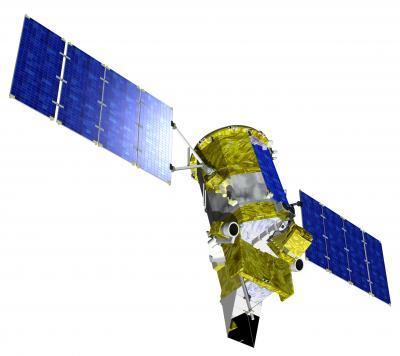A $28 million University of Colorado Boulder instrument developed to study changes in the sun's brightness and its impact on Earth's climate is one of two primary payloads on NASA's Glory mission set to launch from Vandenberg Air Force Base in California on Feb. 23.
Designed and built by a team from CU-Boulder's Laboratory for Atmospheric and Space Physics, the instrument called the Total Irradiance Monitor, or TIM, will point directly toward the sun to measure both short- and long-term fluctuations in the sun's energy output as it reaches the top of Earth's atmosphere. Such measurements are important because variations in the sun's radiation can influence long-term climate change on Earth, said LASP researcher Greg Kopp, principal investigator on the TIM.
The Taurus XL rocket ferrying the Glory satellite also will be carrying a tiny CU-Boulder satellite designed and built by about 100 students, primarily undergraduates, who are participating in the Colorado Space Grant Consortium. The CubeSat satellite will be ejected from the rocket at about 400 miles in altitude to orbit the Earth and study new space communications techniques.
The CU-Boulder solar instrument on Glory is the most accurate instrument ever made to study the energy output from the sun and will continue a 32-year-long data record of solar radiation by NASA and other agencies, said Kopp. NASA's Solar Radiation and Climate Experiment, a $100 million satellite designed, built and operated by CU-Boulder's LASP and launched in 2003, is equipped with a first-generation TIM instrument as well as three other solar measuring instruments.
"We'd like to know how the sun's energy changes over both the short and long term," said Kopp. "This spacecraft is carrying extremely sensitive instruments for monitoring solar variability, which makes the mission especially relevant given climate change on Earth and the importance of determining the natural influence on those changes."
Glory will join five other NASA Earth-observing satellites as part of the Afternoon Constellation, or "A-Train," a tightly grouped series of spacecraft that circle the globe several times each day to gather information on Earth's biosphere and climate, including hurricane behavior and climate change. The A-Train spacecraft follow each other in close formation, flying mere minutes apart. The A-Train orbits Earth about once every 100 minutes.
The second primary instrument on the Glory mission, called the Aerosol Polarimetry Sensor, or APS, was built by Raytheon Space and Airborne Systems in El Segundo, Calif. Scientists hope to learn how tiny liquid and solid aerosols -- most smaller than the diameter of a human hair -- influence climate on Earth.

NASA's Glory mission is carrying a $28 million CU-Boulder instrument designed to study fluctuations in the sun's brightness and its impact on Earth's climate.
(Photo Credit: NASA)
Using Glory as well as prior and subsequent missions to measure solar radiation changes, scientists hope to determine how much energy reaches Earth on timescales of decades to centuries, influencing Earth's long-term climate.
Scientists previously have shown that the overall output of the sun can change up to about 0.1 percent over the duration of a solar cycle, which lasts about 11 years. But such short-term variations cannot explain the warming seen on Earth in the past several decades. The vast majority of climate scientists agree global warming is due primarily to human-produced greenhouse gases building up in the atmosphere.
"In attributing climate change causes, solar variability measurements such as those from Glory are necessary to discriminate the natural from the human-caused effects on the climate," Kopp said.
LASP has a long record of measuring solar radiation with various satellites and sounding rockets, including the Solar Mesosphere Explorer satellite that flew from 1981 to 1988 and which was dubbed "The Classroom in Space." SME measured ozone and solar radiation and involved undergraduate and graduate students in virtually every phase of the effort, from design and development to hands-on control of the satellite from campus.
Because of technological advances, the TIM riding on Glory is expected to be three times more accurate than the TIM flying on CU-Boulder's SORCE satellite, according to Kopp. The improvement is due in large part to better electrical design and more precise calibrations of solar space instruments that are being made using a new NASA-funded facility at LASP.
The second CU-Boulder payload, a CubeSat satellite dubbed Hermes that was designed and built by students, primarily undergraduates, is about four inches on a side -- roughly the size of a Rubik's Cube. The goal is to improve communications systems in tiny satellites through orbital testing that may pave the way for scientists to downlink large quantities of information, said Colorado Space Consortium Director Chris Koehler.
The students will be in contact with the Hermes satellite from atop the Discovery Learning Center, part of CU-Boulder's College of Engineering and Applied Science, said senior aerospace engineering sciences major Nicole Doyle, Hermes project manager. Ten CU-Boulder students will be traveling to California for the Hermes launch.
Hermes is part of NASA's Educational Launch of Nanosatellites, or ELaNa, project. Two other CubeSat satellites will be aboard the Taurus rocket with Glory, one from Montana State University and one from Kentucky Space, a consortium of Kentucky state institutions.
Doyle said when she first came to CU-Boulder she was surprised to discover that undergraduates had regular opportunities to design, build, test and fly spacecraft. "This has been an incredible experience for me," she said. "We learn from other CU students who are working on other space projects and who have experience in the kinds of research we are doing with Hermes. This is a great opportunity for students like me who want to work in the aerospace industry after college."